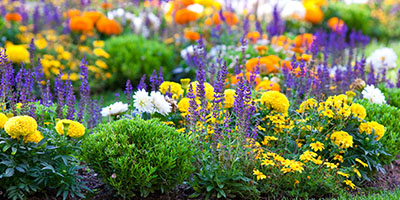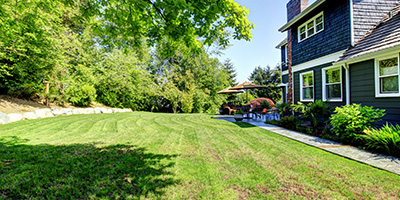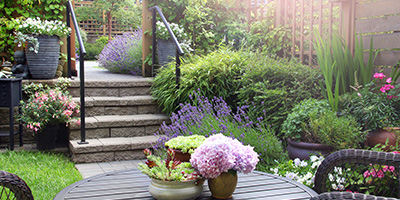Make Your Backyard Dog-Friendly With These Simple Tips

7 Dog-Friendly Backyard Ideas
You don’t have to choose between a happy dog and a well-manicured lawn. With a few minor changes, you’ll have the best yard for dogs that looks great and keeps your pup safe.
Not sure how to make a fun yard for your dog? Use these seven tips to create a backyard that suits you and your pooch.
7 Dog-Friendly Backyard Ideas On a Budget
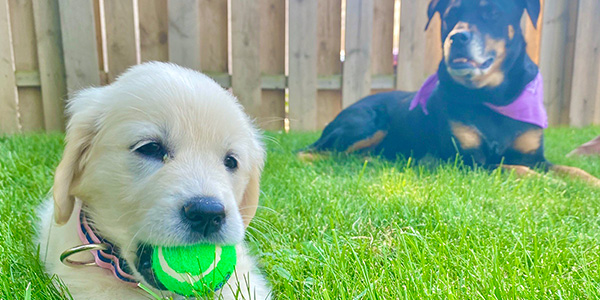
1. Install a Dog-Friendly Fence
Dogs need plenty of space to exercise and get the zoomies out of their system. Installing a dog-friendly fence will let your pup safely stretch their legs, while also adding privacy and increasing your home’s value. To ensure the fence can accommodate your pet, make sure it’s tall enough to prevent an escape, wiggle-proof and doesn’t have sharp ends.
For a small yard, fence in the whole area to make it feel bigger. If you have a larger yard, only fence in part of it to create a dog run and leave room for dog-safe flowers. Not only will this give your pup their own private space, it’s more budget friendly than installing a fence around your entire backyard.
You can also choose an invisible, electric fence for a quicker installation and a lower cost.

“Ideally, dogs need room to roam, a place to run, a spot to hang out in the shade and a safe area they can enjoy. A fenced backyard is a great option not only so you don’t have to worry about your dog running away (or, sadly, being dognapped) but you can also breathe easier about the risk of another dog coming into your yard and starting a fight.”
Paris Permenter, DogTipper
2. Choose a Dog-Friendly Ground Cover
When it comes to landscaping, brown spots in the grass are one of the biggest problems for dog owners. You can prevent these spots by rinsing the area with water as soon as your dog is finished urinating, but this can be difficult to keep up with. Avoid this tedious task by installing grass alternatives for dogs in your backyard.
For green lawns, choose between:
- Clover: Clover is safe for dogs to eat, tougher than grass and less likely to stain your clothes. With an average cost of $4 per 4,000 square feet, it’s less likely to strain your wallet as well.
- Synthetic turf: Turf is a low maintenance option that will not stain. It also reduces the need for other types of yard work, like mowing, and prevents your dog from digging. If you’re installing synthetic turf, expect to pay between $5.50 to $18.75 per square foot.
- A more durable grass blend: While no grass is completely immune to stains, tougher types like Buffalo Grass or Kentucky Bluegrass withstand urine better. Plus, the price typically ranges from $0.30 to $0.55 per square foot, so you can install it without worrying about your budget.
If you want to avoid grass completely, these are the best alternative ground covers for dogs:
- Stone: Smooth stones are visually-appealing and easy on your dog’s paws. However, it would cost you $600 to create a 20 square foot dog area, making it a pricier ground cover.
- Mulch: A safe, inexpensive option, mulch can create a designated dog area for as little as $35 to $110 per yard. Cedar mulch has the added benefit of being a natural bug repellent that can help fight off fleas and ticks. Remember to avoid cocoa bean mulch, which isn’t safe for dogs to consume. If you install the mulch yourself, you can save an extra $45 per yard.
It’s also a good idea to train your dog to use one area of the lawn as a bathroom area to help reduce maintenance and upkeep.
3. Grow Dog-Safe Flowers and Plants
When designing your dog-friendly garden, choose your plants carefully. Some plants can be poisonous if ingested by animals. If your furry friend will eat basically anything, make sure to plant dog-safe flowers exclusively.
“Of course, you never want to allow your pets to chew on any plants, but you can feel a little more at ease around plants such as Aster, Corn Flower, Hibiscus, Impatiens, Marigolds, Pansies, Petunias and Snapdragons,” says Karen Uthe Semancik, co-publisher and editor at CLE DOG magazine.
Dog-Safe Flowers and Plants
- Snapdragons
- Marigold
- Cilantro
- Sage
- Sunflowers
- Tiger Lilies
- Zinnia
Plants That Are Poisonous to Dogs
- Chrysanthemum
- Dahlia
- Iris
- Lily of the Valley
- Peony
- Begonia
- Hydrangea
For a full list of poisonous plants for animals, visit the ASPCA.
Fertilize Your Lawn Carefully
When creating your dog-friendly backyard design, choose your lawn products with care. Some fertilizers and weed blockers can be dangerous for animals.

“Fertilizers are great for your lawn and garden but can be deadly to your pets. Be sure to apply fertilizer per the instructions on the label and keep your pets off the lawn and out of the garden until it has been watered or has rained and the fertilizer has dried. To play it safe, consider a pet-safe lawn care service or product, or use natural, organic methods.”
Karen Uthe Semancik, CLE DOG Magazine
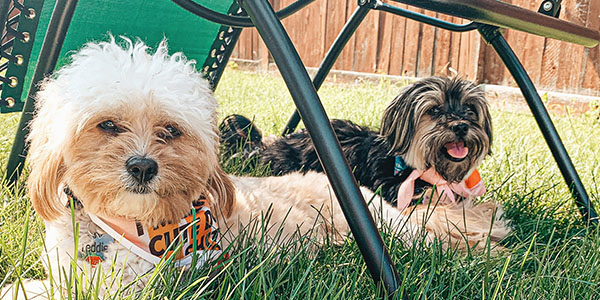
4. Create Shade in Your Yard
Dogs love to sunbathe, but shade is important so they don’t overheat in the summer. Include tall trees, bushes or tall grasses in your landscape design so your pet can stay cool when he’s finished playing fetch.
A decorative doghouse can also be a great addition to your yard design and provide a convenient shady spot for your dog.
5. Install a Water Feature
Make sure your dog can stay cool in the spring and summer by adding a water feature to your backyard. Not only will this keep your dog hydrated, but provide her with hours of entertainment during the warmer months.
Options include:
- Decorative fountain.
- Dog pool.
- Sprinkler system.
- Dog watering system connected to your outdoor hose.
Place the water feature in the shade when possible.
6. Build a Backyard Dog Path
A dog’s natural instinct will be to patrol your yard and protect your home, even if he’s only scaring off squirrels. Dogs tend to run the same backyard routes, wearing down the grass and leaving brown spots in their wake. Instead of preventing your pup from patrolling, build a backyard dog path that looks decorative and polished.
Using your dog-friendly ground cover, start making a path over your dog’s tracks. If there isn’t a path yet, place it around the boundary of your yard or up against the fence where your dog will naturally patrol. Make sure it has soft curves instead of right angles because a fast-moving dog will cut corners.
Need to get rid of your yard waste after completing these projects? Check out our Yard Waste Disposal Guide!
7. Install a Sandbox
Does your dog ruin your landscaping by digging it up? Install a sandbox to keep him out of your flower beds. We suggest placing it in an unused corner of your yard that’s out of sight. Fill the box with sand or mulch that’s easy to dig up and refill.
Show your dog this is the right place to dig by burying his favorite toys or bones in the box.

“It’s great to include dedicated play areas in a yard, depending on your dog’s interests and life stage. Puppies and young dogs might enjoy a sandbox (bury some treats, chews or toys). [It’s] a great way to satisfy your dog’s need to dig while at the same time saving the rest of your yard!”
Paris Permenter, DogTipper

